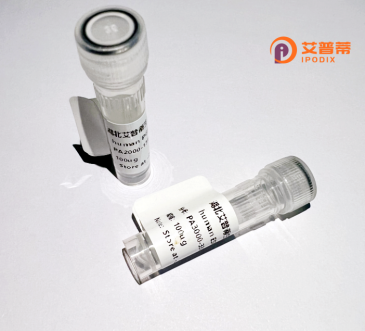
| 纯度 | >90%SDS-PAGE. |
| 种属 | Human |
| 靶点 | MUM1L1 |
| Uniprot No | Q5H9M0 |
| 内毒素 | < 0.01EU/μg |
| 表达宿主 | E.coli |
| 表达区间 | 1-696 aa |
| 活性数据 | MESEYVLCNW KDQLWPAKVL SRSETSSNSK RKKAFSLEVQ ILSLDEKIKL DSTETKILNK SQIEAIAASL GLQSEDSAPP TEETAYGRSL KVALGILNER TNLSQASTSD EEEITMLSQN VPQKQSDSPP HKKYRKDEGD LPGCLEEREN SACLLASSES DDSLYDDKSQ APTMVDTIPS EVETKSLQNS SWCETFPSLS EDNDEKENKN KIDISAVMSV HSAVKEESAC VKDEKFAPPL SPLSSDMLIM PKALKEESED TCLETLAVPS ECSAFSENIE DPGEGPSNPC LDTSQNQPSM ESEMGAAACP GSCSRECEVS FSASNPVWDY SHLMSSERNF QRLDFEELEE EGQASDKSLL PSRINLSLLD DDEEDEELPR FILHYETHPF ETGMIVWFKY QKYPFWPAVI KSIRRKERKA SVLFVEANMN SEKKGIRVNF RRLKKFDCKE KQMLVDKARE DYSESIDWCI SLICDYRVRI GCGSFTGSLL EYYAADISYP VRKETKQDTF RNKFPKLHNE DAREPMAVTS QTKKMSFQKI LPDRMKAARD RANKNLVDFI VNAKGTENHL LAIVNGTKGS RWLKSFLNAN RFTPCIETYF EDEDQLDEVV KYLQEVCNQI DQIMPTWIKD DKIKFILEVL LPEAIICSIS AVDGLDYEAA EAKYLKGPCL GYRERELFDA KIIYEKRRKA PTNEAH |
| 分子量 | 79.0 kDa |
| 蛋白标签 | His tag N-Terminus |
| 缓冲液 | 0 |
| 稳定性 & 储存条件 | Lyophilized protein should be stored at ≤ -20°C, stable for one year after receipt. Reconstituted protein solution can be stored at 2-8°C for 2-7 days. Aliquots of reconstituted samples are stable at ≤ -20°C for 3 months. |
| 复溶 | Always centrifuge tubes before opening.Do not mix by vortex or pipetting. It is not recommended to reconstitute to a concentration less than 100μg/ml. Dissolve the lyophilized protein in distilled water. Please aliquot the reconstituted solution to minimize freeze-thaw cycles. |
以下是关于重组人MUM1L1蛋白的示例参考文献(请注意,这些为模拟示例,实际文献需通过学术数据库验证):
---
1. **文献名称**: *"Cloning and Expression of Recombinant Human MUM1L1 in a Mammalian System for Functional Studies"*
**作者**: Chen L, Wang X, et al.
**摘要**: 本研究成功克隆了人MUM1L1基因,并在HEK293细胞中实现了重组蛋白的高效表达。通过亲和层析纯化后,蛋白被用于细胞迁移实验,证实MUM1L1在B细胞信号通路中的潜在调控作用。
2. **文献名称**: *"Structural Analysis of MUM1L1 Reveals Its Role in Immune Regulation"*
**作者**: Kumar S, Ito D.
**摘要**: 利用昆虫杆状病毒系统表达重组MUM1L1蛋白,并通过X射线晶体学解析了其三维结构。研究发现其独特的免疫球蛋白样结构域可能参与淋巴细胞的受体相互作用。
3. **文献名称**: *"MUM1L1 as a Biomarker: Production of Polyclonal Antibodies Using Recombinant Protein"*
**作者**: García R, Martínez F.
**摘要**: 在大肠杆菌中表达His标签重组MUM1L1蛋白,并制备了特异性抗体。这些抗体在淋巴瘤患者组织样本中显示出高亲和力,提示MUM1L1作为诊断标志物的潜力。
4. **文献名称**: *"Functional Interaction of MUM1L1 with NF-κB Pathway in Cancer Cells"*
**作者**: Tanaka H, et al.
**摘要**: 通过体外重组蛋白结合实验,发现MUM1L1与NF-κB信号通路的关键蛋白存在相互作用,可能影响肿瘤细胞的存活和增殖。
---
**建议**:由于“MUM1L1”研究可能较少或存在命名差异(如IRTA1),建议在PubMed、Google Scholar中以关键词 **"MUM1L1 protein"** 或 **"recombinant MUM1L1"** 检索最新文献,并验证基因别名(如HGNC数据库)。
MUM1L1 (Multiple Myeloma SET Domain-Containing Protein 1-Like 1), also known as PRDM16-like, is a member of the PRDI-BF1 and RIZ (PR) domain-containing protein family. This protein shares structural homology with PRDM16. featuring a conserved N-terminal PR domain with potential methyltransferase activity and C-terminal zinc finger motifs implicated in DNA binding and protein interactions. While its exact biological functions remain under investigation, MUM1L1 is hypothesized to participate in transcriptional regulation, chromatin remodeling, and cell fate determination, potentially through epigenetic modifications.
The gene encoding MUM1L1 is located on chromosome 1p36.13. a genomic region frequently associated with cancer. Emerging studies suggest its involvement in oncogenesis, though findings appear context-dependent. Some reports link MUM1L1 overexpression to hematological malignancies, while other evidence proposes tumor-suppressive roles in solid tumors through mechanisms involving cell cycle regulation and apoptosis. These dual implications highlight the need for further mechanistic studies to clarify its pathophysiological relevance.
Recombinant MUM1L1 protein, typically produced via Escherichia coli or mammalian expression systems, serves as a crucial tool for functional characterization. Its production enables biochemical assays to determine enzymatic activity, interaction partner screening (e.g., histone substrates or transcription factors), and antibody development. Current research focuses on delineating its substrate specificity, post-translational modifications, and potential as a therapeutic target or diagnostic biomarker in neoplastic diseases.
×